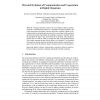Free Online Productivity Tools
i2Speak
i2Symbol
i2OCR
iTex2Img
iWeb2Print
iWeb2Shot
i2Type
iPdf2Split
iPdf2Merge
i2Bopomofo
i2Arabic
i2Style
i2Image
i2PDF
iLatex2Rtf
Sci2ools
ECAL
2007
Springer
2007
Springer
Directed Evolution of Communication and Cooperation in Digital Organisms
This paper describes a study in the use of digital evolution to produce cooperative communication behavior in a population of digital organisms. The results demonstrate that digital evolution can produce organisms capable of distributed problem solving through interactions between members of the population and their environment. Specifically, the organisms cooperate to distribute among the population the largest value sensed from the environment. These digital organisms have no “built-in” ability to perform this task; each population begins with a single organism that has only the ability to self-replicate. Over thousands of generations, random mutations and natural selection produce an instruction sequence that realizes this behavior, despite continuous turnover in the population.
Artificial Intelligence | Cooperative Communication Behavior | Digital Evolution | Digital Organisms | ECAL 2007 |
| Added | 07 Jun 2010 |
| Updated | 07 Jun 2010 |
| Type | Conference |
| Year | 2007 |
| Where | ECAL |
| Authors | David B. Knoester, Philip K. McKinley, Benjamin E. Beckmann, Charles Ofria |
Comments (0)

